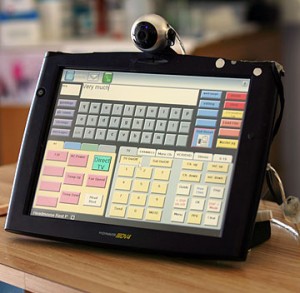
I barely remember mom’s voice. The last time she tried to talk to me was over the phone after a family vacation to Ocean Shores. I left a day early because Erin needed to get back to work. On the way home, mom called to ask me something. I couldn’t understand a word she said.
Dad fared better than I did. He was able to interpret mom’s grunts four or five months longer than I could.
At the first A.L.S.A. support group meeting mom went to, someone there loaned her a Dynavox. Basically a talking computer. It has a touch screen that lets you pick letters or words. It has a computer generated voice that speaks what you’ve typed. It’s portable, at least compared to a laptop. Thing weighed more than my laptop though. But it’s design makes it more usable for carrying and speaking than a laptop. Under the hood it ran Windows CE, so it had typical Windows stability issues. The new versions run Windows XP.
Mom had a love/hate relationship with her Dynavox. I asked her to practice with it before she needed to use it. I figured it would be easier to solve any problems with it when she could still talk. But she didn’t. It was too slow. And it was too much like giving up. So she only started using it after her speech was nearly gone.
A Dynavox is a pretty versatile machine, but it’s not designed specifically for A.L.S. patients. It’s primary users are seriously mobility impaired, paralyzed, or with severe loss of fine motor control. Eventually mom got to that point, but not until the last few months she was alive. A.L.S. patients tend to lose their speech either near the beginning of their illness (in the case of bulbar onset A.L.S.) or near the end (in limb onset A.L.S.). There are exceptions, but these are the general cases.
For those with bulbar onset A.L.S., using the touch screen is pretty slow. You can use a U.S.B. keyboard with a Dynavox. Mom could still type 60+ words a minute. So she didn’t slow down that much actually at first. The problem was that you couldn’t map any key on the keyboard to be speak
or clear
. So she’d have to reach over to the touch screen to make it say what she’d typed. And then she’d have to reach over again to clear it so she could type her next sentences.
Even so, she talked
slower than she used to, but was still just as wordy as ever. For instance, Mom would still preface her statements with To answer your question …
followed by the answer, rather than just answering. I constantly battled with having the patience to wait for her to get through her wordiness with a slower mode of communication. Not everyone had the patience. Having visitors over would be difficult because while they waited for mom to type something, they would continue the conversation with other people in the room. By the time mom pressed Speak
, the conversation would have moved on.
As mom lost the use of her hands, it became more difficult for her to type. Again the A.L.S.A. helped out, this time with buttons and switches and a giant trackball. Instead of typing, she would use the trackball to click on stuff on screen. It was slow, but the Dynavox has built in word prediction, something like what cell phones do.
The A.L.S.A. actually helped out with two Dynavox machines. While they are pretty sturdy, they don’t stand up to repeated abuse. Mom’s Dynavox got dropped a few times. Eventually it stopped working. Once when the U.S.B. port was damaged. Another time when the screen stopped responding. Both times the A.L.S.A. had a second machine for mom to use while the original was getting repaired.
At $7500 a pop, that’s a hell of a lot of help. Mom had pretty good insurance, but they didn’t cover communication. Speech aids were specifically excluded. Most A.L.S. patients don’t have insurance coverage for A.A.C. Without the A.L.S.A., they’d be S.O.L.
This is one of a number of articles I’m writing to bring up awareness about A.L.S. and to encourage donations to the 2009 Walk to Defeat A.L.S. I’ve set up a donations page to collect money, where donors can claim one of over 100 books as a thank you gift. If you don’t have the money to donate, you can help by publicizing and linking to that page. I’ll be giving away a signed book by Elizabeth Bear for those who help publicize the drive (and more prizes will be forthcoming). More information on that offer can be found here.